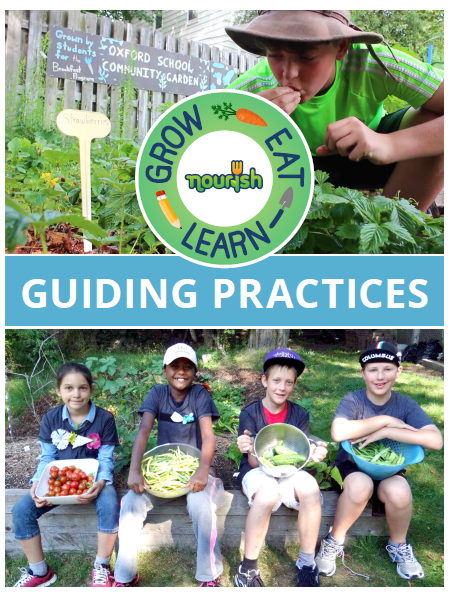Grow Eat Learn Special Announcement!
Amazing things are happening at Nourish! After hearing from school food garden leaders around the province about common challenges they face with their school food gardens, we created a package of supports to help them overcome those challenges - the Grow Eat Learn Guiding Practices.
Grow Eat Learn Guiding Practices are a set of guidelines that are adaptable to each unique school environment and includes elements of planning that will help a school food garden put down roots for years to come. As the cornerstone of the Grow Eat Learn program, the Guiding Practices are evidence-based and have been informed by the wisdom and diverse experiences of local garden leaders, teachers and community groups. Download your free copy today!
The Importance of School Food Gardens
“Students have obtained knowledge and practical life skills that I observe and hear them sharing with other students within the school. Students have taken their knowledge and planted gardens at their homes as well.” - School food garden leader
School food gardens are sites of learning; they teach essential skills for students’ success and well-being. Grow Eat Learn Guiding Practices help unlock the full potential of school food gardens.
The Grow Eat Learn Guiding Practices
There are 7 guiding practices that make up the Guiding Practices document. Each practice was designed to be a separate section in a school food garden binder, to help you with your record keeping and planning. To help you begin to implement each practice there is a suite of resources on our website - planning templates, gardening books, how-to videos, and supporting websites - everything you need to get started and revitalize your garden today!
Plan Evaluate and Share: Planning for growth helps envision not only the physical space but how the school food garden can serve the needs of the school and school community. You could, for example, explore The GREEN Tool Map and use it to operationalize steps to maintaining the garden. To share the successes of the garden, you could write a blog about the garden, or present about it at school staff meetings, as suggested here.
Learn in the Garden: Garden lessons can be delivered across all subjects and grades. For example you could have students create garden themed art by designing garden signage or creating a garden documentary. You could also connect the garden to science by counting and measuring plants, observing growth and recording outcomes.
Connect with Nature: School food gardens promote cooperative learning and stimulate students’ curiosity about the natural world, helping them learn to care for whole and healthy ecosystems and the people that live in them.
Co create welcoming and inclusive spaces: School food gardens should be accessible, inclusive and inviting spaces that allow for people of all ages, cultures, abilities, and backgrounds to participate to their fullest potential. To begin you could create accessible signage in different languages, design wheel-chair access to the garden, or hold a Mikmaw lesson in the garden.
Strengthen the school community: Gardens can function as intergenerational bridges, creating opportunities for older adults and children to socialize and transfer ideas from one generation to the next. Using Nourish’s volunteer recruitment materials, you could bring more community members into the garden to facilitate those interactions.
Create a safe environment: Staying safe is important so ensuring some volunteers have first aid, and using this checklist (p. 26) to ensure everybody practices safe food handling, is a good idea (p.23).
Sustaining school food gardens: This guiding practice was designed to help long term planning, so that the garden can overcome changes in staffing or involvement. Some supporting resources include the School Garden Action Plan, and the ‘How do we keep going?: Motivation and ownership’ document.
“The connections made to curricula concerning ecology and eco-systems, looking after our planet and being responsible and mindful citizens of earth are immeasurable.” - School food garden leader
Check Out the Resources Today
This has just been a sneak peek of all the supporting tools we have to offer. Head on over to nourishns.ca/grow-eat-learn to explore our whole suite.
Is anybody else in your circle working or volunteering with school food gardens? Send them Guiding Practices today!
Thank you for your continued efforts in helping us build generations of healthy citizens, one garden at a time.


